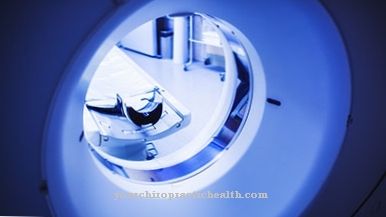Of the Piebaldism is a form of albinism that is caused by a mutation. The white forelock is characteristic of those affected. Because of its depigmentation, patients are more susceptible to black skin cancer from UV light and should avoid excessive exposure to the sun.
What is piebaldism?

© meletver - stock.adobe.com
Albinism corresponds to a group of hereditary diseases that manifest themselves in the form of an extreme deficiency in the pigment melanin. Melanin is produced by melanocytes in the skin, iris and hair. The pigment is responsible for the color of the skin, eyes and hair, whereby in humans it is composed of two different subspecies.
In addition to the yellowish pheomelanin, the dark brown eumelanin is a variant of melanin. The individual color of eyes, hair and skin results from the respective proportions of the two melanin variants. In albinos, melanin production by melanocytes is disturbed, for example by mutation-related defects in the enzyme tyrosinase required for this.
Of the Piebaldism will also be Partial albinism or partial albinism called and represents a sub-form of albinism, which is mainly characterized by white spots on the face, in the neck area, on the front of the torso and the flanks. The disease is one of the rare hereditary diseases and can occur in different variants. Waardenburg syndrome and Wolf syndrome, for example, are now being discussed as variants of the disease.
causes
Piebaldism is inherited as an autosomal dominant trait. Familial accumulation was observed in the cases documented so far. Apparently the disorder is based on depigmentation due to an embryonic melanoblast differentiation disorder. The melanocytes of those affected have not migrated sufficiently.
A mutation-related defect in the gene that codes for the melanocytic tyrosine kinase receptor is responsible for the inadequate migration. The disease is thus based on mutations in the receptor-expressing c-KIT gene, which is located on the long arm of chromosome 4 in locus 4q12. The embryonic melanoblast differentiation is disturbed by the genetic defect.
In addition, the melanocyte migration out of the neural crest is hindered. The Waardenburg syndrome and the Wolf syndrome are different variants of the phenomenon, whereby the Waardenburg syndrome is also associated with an inner ear hearing loss and the Wolf syndrome with an additional one with malformations, short stature and developmental delays on a mental and physical level.
In Wolf syndrome, the cause corresponds to a structural chromosome aberration on the short arm of chromosome 4, while Waardenburg syndrome can be based on various mutations.
Symptoms, ailments & signs
In most cases, patients with piebaldism develop a typically white forelock. This symptom of poliosis occurs in around 90 percent of all cases. In addition, there is a circumscribed hypopigmentation of the skin, which is also known as leukoderma. In the individual depigmentations, there are often patchy hyperpigmentation of the skin.
That is, within the unpigmented areas there are demarcated spots with excessive pigment. The shape of the white forelock is particularly characteristic: this is a hair heterochromia, i.e. a different color of the hair. In most cases, the tip of the forelock points downwards. Depending on the causal mutation and thus the variant of piebaldism, the symptoms described can be associated with other symptoms.
In Waardenburg syndrome, different-colored eyes are part of the clinical picture in addition to the hearing loss in the inner ear. As a rule, one eye of the patient appears noticeably lighter than the other, which is attributable to the depigmentation. Wolf syndrome, on the other hand, is associated with short stature and malformations in the face.
Diagnosis & course of disease
To diagnose piebaldism, the doctor takes a closer look primarily at the skin spots. Depigmentations are sharp or blurred spots in the area of the trunk, forehead and often the extremities that have overpigmented spots in small areas.
Together with depigmentation of scalp hair, eyebrows and iris, these observations support the diagnosis. The diagnosis is usually based on visual diagnosis. In cases of doubt, molecular genetic mutation detection can serve to exclude other diseases from a differential diagnosis.
Complications
Piebaldism, as a rule, does not cause serious complications. However, those affected suffer from cosmetic changes that can have a negative effect on the psyche, especially if the disease is severe. If the piebaldism is left untreated, the skin changes increase and sometimes spread to the entire face.
This not only represents a visual flaw, but also increases the risk of skin diseases. Occasionally this leads to infections or inflammations, which in turn are associated with complications. The disease is also suspected of increasing the risk of skin cancer.Further complaints are based on possible comorbidities. The Waardenburg syndrome can lead to inner ear hearing loss and eyes of different colors. Wolf syndrome is associated with short stature and malformations of the face.
Since the disease is genetic, these complications and possible secondary diseases can hardly be avoided. Those affected therefore feel above all an emotional level of suffering that can cause long-term mental illness. This can result in physical complaints and a noticeable decrease in quality of life. An early clarification of the piebaldism enables at least symptomatic therapy.
When should you go to the doctor?
Piebaldism is not a mandatory reason for a doctor's visit, as long as it is limited to the characteristic white hair on the head. The typical white forelock is noticeable, but it is harmless and can be colored if the person concerned has an aesthetic problem with it. There is no causal treatment for piebaldism anyway, so the doctor cannot offer any therapeutic options. On the other hand, medical control is important for variants of piebaldism, von Waardenburg syndrome and Wolf syndrome. Like piebaldism, these are very rare, but they are associated with disabilities and complications.
Since these are also hereditary diseases, the first clinical symptoms are often noticeable soon after the child is born and the respective disease must be treated accordingly early. As soon as piebaldism is recognized in the child, the pediatrician should be consulted for safety's sake to clarify whether it is really just a harmless manifestation of piebaldism or a variation with possible effects on health.
Especially during school days, cases of piebaldism can lead to bullying, depending on how big and noticeable the white hair area is. The doctor cannot change the visual appearance of piebaldism, but parents and affected children can advise what they can do to conceal it.
Treatment & Therapy
Piebaldism cannot be treated causally. All forms are based on mutations that cannot be reversed. For this, symptomatic treatment of the individual symptoms can take place to a certain extent. In most cases, symptomatic treatment consists simply of sun protection and cosmetic measures.
Different colored eyes can be matched to one another with colored contact lenses, for example. Melanin takes on the role of a UV filter in the skin, especially in its dark brown color. The dark dye converts harmful UV light into thermal radiation, rendering it harmless. People with piebaldism, like people with other forms of albinism, should therefore avoid high levels of UV exposure.
They have a higher risk of developing black skin cancer. Sun protection measures can reduce the risk. If one would like to consider Waardenburg and Wolf syndromes as forms of piebaldism, a more comprehensive therapy is indicated for these two variants.
However, this focuses less on the depigmentation than on the symptoms of inner ear hearing loss and malformations. In many cases, the malformations of Wolf Syndrome in particular can be corrected surgically.
You can find your medication here
➔ Medicines for pale skinOutlook & forecast
As a rule, piebaldism cannot be completely cured because it is a genetic disease. In some cases, only the symptoms of the disease can be alleviated, although the person affected has to live with the symptoms his entire life. Self-healing cannot occur either. In order to prevent piebaldism from recurring in the children, genetic testing and counseling should first be carried out if the child wishes to have children. Since those affected by the disease also have an increased risk of developing skin cancer, regular controls and examinations by a dermatologist are necessary. This is the only way to prevent further spread of the tumor.
The treatment itself can alleviate some of the symptoms, whereby the person affected will always have to rely on the application of sun creams and must avoid exposure to direct sun in any case. With the help of various care products, the symptoms of incorrect pigmentation can also be alleviated. Surgical interventions can possibly alleviate these complaints. In most cases, piebaldism will not reduce the person's life expectancy if, in particular, regular skin exams are taken.
prevention
Since piebaldism is based on a hereditary mutation, there are few preventive measures available. After genetic counseling in the family planning phase, sick people can at most decide against having their own children. Since piebaldism is not an overly serious disease, such a decision seems almost too radical. At most, with the variant of Wolf Syndrome, the decision would still be understandable.
Aftercare
In most cases, patients with piebaldism have few direct follow-up measures available. The disease itself does not have to be treated completely, and in most cases a complete cure is not possible at all. In general, those affected by piebaldism should protect their skin particularly well against the sun and therefore ideally not expose themselves to UV radiation without protection.
When staying outdoors, sunscreen should always be applied to prevent sunburn. Regular checks and examinations by a dermatologist are also very important in piebaldism in order to identify and treat damage to the skin at an early stage. Even with the smallest changes on the skin, a doctor should be contacted so that a possible tumor can be recognized and removed at an early stage.
Some of the symptoms of piebaldism can be alleviated with the help of minor interventions. The person affected should take good care of and protect their skin. Various creams and ointments may be prescribed by a doctor to be used regularly. It cannot be universally predicted whether piebaldism will lead to a reduced life expectancy of the person affected.
You can do that yourself
Piebaldism does not necessarily have to be dealt with. It is a purely visual flaw that does not cause any physical or psychological complaints. In individual cases, however, the gray coloring of the hair can lead to inferiority complexes and other mental problems.
People who feel very stressed by partial albinism should speak to a therapist first. It is possible to dye the hair or wear suitable headgear to hide the silver lock. In addition, the discoloration can be reduced by certain care products. A balanced diet slows the course of the disease by compensating for the causal hypopigmentation of the skin. A diet that contains as many foods as possible with natural colorings is recommended. Carrots and tomato juice, among other things, have proven themselves.
If the piebaldism becomes stronger despite the above measures, the family doctor should be consulted. In individual cases, the appearance of a white forelock is due to a serious condition that needs to be diagnosed and treated. Finally, those affected should accept the suffering by talking to other affected persons or having a therapy discussion. The forehead curl can no longer be seen when using hair dye and further symptoms are not to be expected.




.jpg)

.jpg)

















.jpg)



